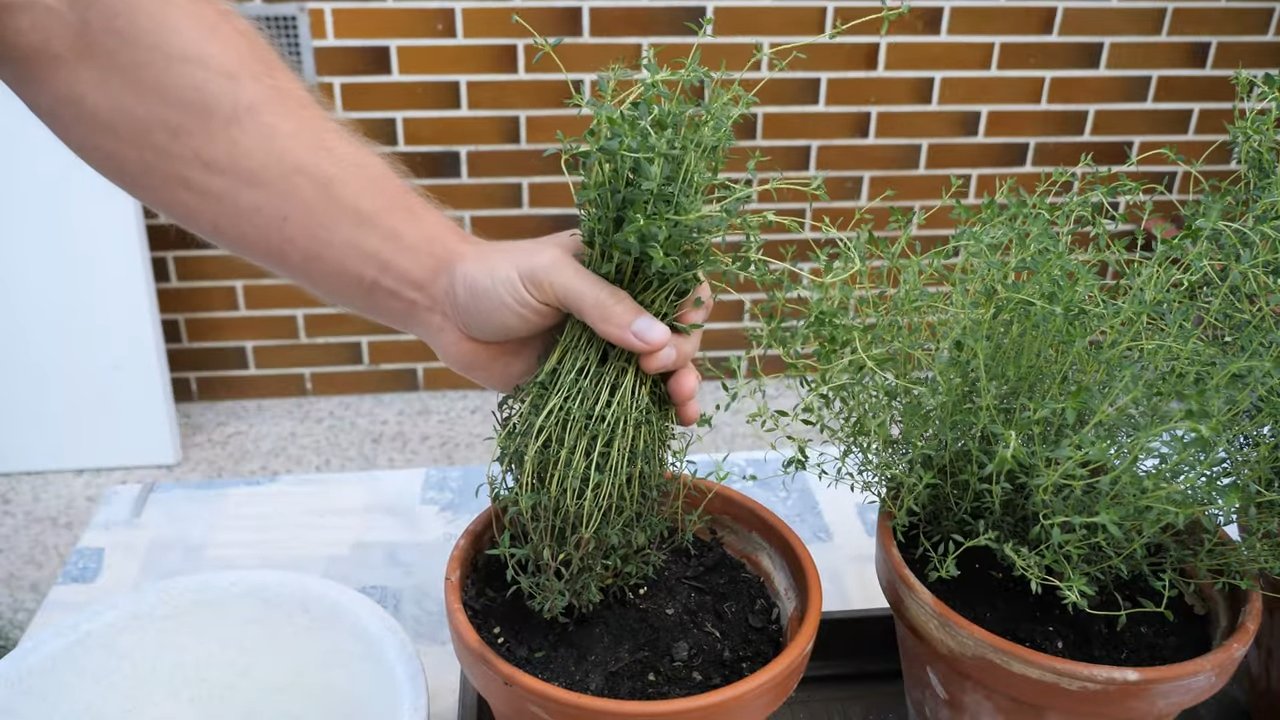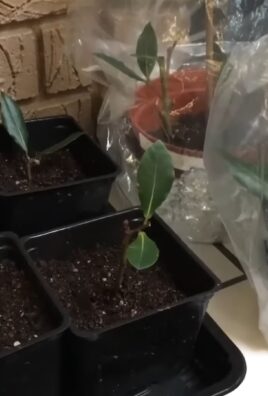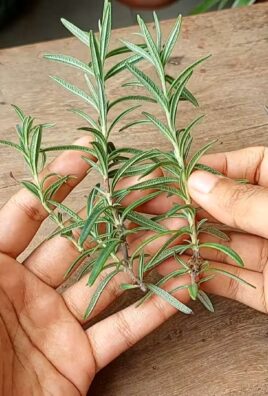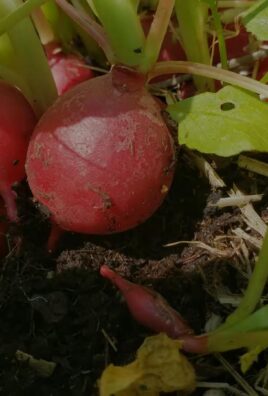Growing Thyme at Home doesn’t have to be a daunting task! Imagine stepping outside your door and snipping fresh, fragrant thyme to elevate your culinary creations. No more bland dishes – just a burst of herbaceous flavor at your fingertips. But what if I told you that cultivating this versatile herb is easier than you think, even if you don’t have a sprawling garden?
Thyme, with its rich history dating back to ancient Egypt where it was used for embalming, and its association with courage and bravery in ancient Greece, has long been valued for its medicinal and culinary properties. For centuries, cultures around the world have recognized the power of this humble herb. But in today’s fast-paced world, many of us have lost touch with the simple pleasure of growing our own food.
That’s where these DIY tricks and hacks come in! I’m going to share some simple, yet effective methods to help you successfully start growing thyme at home, regardless of your experience level or available space. Whether you’re a seasoned gardener or a complete beginner, these tips will empower you to cultivate your own thriving thyme patch. From choosing the right variety to mastering propagation techniques, I’ll guide you through every step of the process. So, let’s ditch the store-bought dried herbs and embark on a journey to fresh, flavorful thyme, grown right in your own home!

Growing Thyme at Home: Your Comprehensive DIY Guide
Hello garden friends! Thyme is not only an aromatic herb that is versatile in the kitchen, but also a beautiful, low-maintenance plant that can enrich your garden or even your balcony. I’ll show you how to easily grow thyme yourself – whether you have a green thumb or are just starting out. Let’s get started!
What You Need for Growing Thyme
Before we begin, here’s a list of everything you’ll need:
- Thyme seeds or thyme cuttings: Seeds are cheaper, but cuttings yield results faster.
- Seed starting mix or high-quality potting soil: It’s important that the soil is well-draining.
- Pots or containers: Make sure they have good drainage.
- Watering can or spray bottle: For watering.
- A sunny location: Thyme loves the sun!
- Optional: Seed trays, a mini-greenhouse, a dibber.
Growing Thyme from Seed: Step by Step
Growing thyme from seed requires some patience, but it’s a rewarding experience.
- Prepare the seed starting containers: Fill your seed trays or small pots with seed starting mix. Lightly press the soil down.
- Sow the seeds: Thyme seeds are very small. Sprinkle them sparingly on the soil. You can press them down lightly, but do not cover them with soil, as thyme is a light germinator.
- Watering: Gently moisten the soil with a spray bottle. Avoid waterlogging.
- Cover (optional): Cover the seed trays with a transparent film or a mini-greenhouse to increase humidity. Air them out briefly every day to prevent mold.
- Location: Place the seed trays in a bright, warm spot. The ideal germination temperature is between 20 and 25 degrees Celsius (68-77°F).
- Patience: Germination can take 14 to 21 days. Keep the soil moist, but not wet.
- Pricking out: Once the seedlings are large enough (about 5 cm / 2 inches high and with several pairs of leaves), you can prick them out. This means transplanting them into larger pots so they have more room to grow.
- Fill the larger pots with potting soil.
- Gently lift the seedlings out of the seed tray with a dibber or a spoon.
- Place each seedling in its own pot and press the soil down lightly.
- Water the seedlings gently.
Propagating Thyme from Cuttings: The Quick Way
Propagating from cuttings is a faster method to get thyme plants.
- Select the cuttings: Cut 5-10 cm (2-4 inch) long cuttings from a healthy thyme plant. Choose shoots that are not flowering.
- Prepare the cuttings: Remove the lower leaves so that about 2-3 cm (1 inch) of the stem is bare.
- Rooting: There are two ways to root the cuttings:
- In water: Place the cuttings in a glass of water. Make sure the leaves are not in the water, as they could rot. Change the water regularly. After a few weeks, roots should form.
- In soil: Stick the cuttings directly into seed starting mix. Moisten the soil and cover the cuttings with a transparent plastic bag or a mini-greenhouse to increase humidity. Air them out briefly every day.
- Planting: Once the cuttings have formed roots (either in water or in soil), you can plant them in pots with potting soil.
- Care: Water the cuttings regularly and place them in a sunny location.
The Right Care for Your Thyme
Thyme is relatively low-maintenance, but you should keep a few things in mind for it to feel at home.
- Location: Thyme loves the sun! Place it in a sunny spot with at least 6 hours of direct sunlight per day.
- Watering: Thyme does not tolerate waterlogging. Water it only when the soil is dry. In winter, it needs even less water.
- Soil: Thyme prefers well-draining, rather dry soil. Avoid heavy, clay soils.
- Fertilizing: Thyme does not need much fertilizer. An occasional feeding with an organic herb fertilizer in the spring is sufficient.
- Pruning: Regular pruning promotes growth and prevents the thyme from becoming woody. Prune it back after the flowering season. You can also regularly harvest individual sprigs.
- Overwintering: Thyme is hardy, but in very cold regions, it can be a good idea to cover it with brushwood or garden fleece. If you have it in a pot, you can also move it to a cool, bright place.
Harvesting and Using Thyme
Harvesting thyme is very simple.
- When to harvest: You can harvest thyme all year round. However, it is most aromatic just before the flowering season.
- How to harvest: Simply cut individual sprigs with scissors.
- How to use: Thyme is versatile. You can use it fresh or dried.
- Fresh: Use it in soups, sauces, meat dishes, vegetable dishes, or as a garnish.
- Dried: Hang the thyme sprigs to dry in an airy, dark place. Once they are dry, you can strip off the leaves and store them in an airtight container.
Common Problems and Solutions
Problems can also arise when growing thyme. Here are some common issues and how to solve them:
- Yellow leaves: Can be a sign of overwatering. Reduce the amount of water and ensure good drainage.
- Mold: Can occur with too high humidity. Ensure good ventilation.
- Pests: Thyme is relatively resistant to pests. Occasionally, aphids may appear. You can combat them with a jet of water or a mild soap solution.
Variety is the Spice of Life: Which Thyme is Right for You?
There are many different thyme varieties, each with its own taste and appearance. Here are some popular ones:
- Common Thyme (Thymus vulgaris): The classic with a strong, spicy aroma.
- Lemon Thyme (Thymus citriodorus): With a refreshing lemon aroma.
- Creeping Thyme (Thymus serpyllum): Ideal as a ground cover.
- Orange Thyme (Thymus vulgaris ‘Fragrantissimus’): With a sweet orange scent.
I hope this guide has helped you to grow your own thyme. Happy gardening and enjoy

Conclusion
So, there you have it! Growing thyme at home isn’t just a whimsical dream for those with sprawling gardens; it’s an achievable reality for anyone, anywhere, with a little sunlight and a touch of care. We’ve walked through the simple steps, debunked common myths, and armed you with the knowledge to cultivate your own fragrant patch of this versatile herb.
But why should you bother? Why dedicate precious windowsill space or a corner of your balcony to growing thyme? The answer is multifaceted. First and foremost, the flavor. Freshly harvested thyme possesses an aromatic intensity that dried thyme simply can’t match. Imagine the vibrant, earthy notes infusing your roasted chicken, your hearty stews, or even a simple grilled cheese sandwich. The difference is palpable, a culinary upgrade that elevates your dishes from ordinary to extraordinary.
Beyond the flavor, there’s the sheer convenience. No more last-minute dashes to the grocery store when a recipe calls for a sprig of thyme. No more settling for the dusty, lackluster dried version when you crave that fresh, herbaceous kick. Your thyme is right there, at your fingertips, ready to be snipped and savored.
And let’s not forget the therapeutic benefits. The simple act of nurturing a plant, of watching it grow and thrive, is incredibly rewarding. It’s a mindful practice that connects you to nature, reduces stress, and brings a sense of calm to your day. Plus, thyme itself boasts a range of medicinal properties, from its antiseptic qualities to its potential cough-suppressing effects.
Ready to take your thyme-growing journey to the next level? Consider experimenting with different varieties. Lemon thyme adds a bright, citrusy note to your dishes, while creeping thyme makes a beautiful ground cover and releases its fragrance when stepped on. Silver thyme offers a visually striking addition to your herb garden with its variegated leaves.
Don’t be afraid to get creative with your containers, either. Upcycle old teacups, repurpose mason jars, or build a vertical garden to maximize your space. The possibilities are endless!
Growing thyme at home is more than just a gardening project; it’s an investment in flavor, convenience, well-being, and a deeper connection to the natural world.
We urge you to give it a try. Start small, be patient, and don’t be afraid to experiment. And most importantly, share your experiences with us! We’d love to hear about your thyme-growing triumphs (and tribulations) in the comments below. What varieties are you growing? What dishes are you using your fresh thyme in? What tips and tricks have you discovered along the way? Let’s create a community of thyme enthusiasts and inspire each other to cultivate our own little patches of herbal happiness. Happy growing!
Frequently Asked Questions (FAQ)
What kind of soil is best for growing thyme?
Thyme thrives in well-draining soil that is slightly alkaline. A mix of potting soil, perlite, and sand is ideal. Avoid heavy clay soils, as they can retain too much moisture and lead to root rot. You can also amend your soil with lime to increase its alkalinity if needed. Remember, good drainage is key to healthy thyme growth.
How much sunlight does thyme need?
Thyme needs at least six hours of direct sunlight per day to thrive. If you’re growing thyme indoors, place it near a sunny window or supplement with a grow light. Insufficient sunlight can lead to leggy growth and reduced flavor. If your thyme starts to stretch towards the light, it’s a sign that it needs more sun.
How often should I water my thyme?
Water thyme sparingly, allowing the soil to dry out completely between waterings. Overwatering is a common mistake that can lead to root rot. Check the soil moisture by sticking your finger into the soil. If it feels dry to the touch, it’s time to water. When you do water, water deeply until water drains out of the bottom of the pot. Reduce watering frequency during the winter months when the plant’s growth slows down.
How do I harvest thyme?
Harvest thyme by snipping off stems with scissors or pruning shears. Avoid cutting more than one-third of the plant at a time, as this can stress the plant. The best time to harvest thyme is in the morning, after the dew has dried. Regular harvesting encourages bushier growth. You can use the fresh thyme immediately or dry it for later use.
How do I dry thyme?
There are several ways to dry thyme. One method is to tie the stems together in small bundles and hang them upside down in a cool, dry, and well-ventilated place. Another method is to spread the thyme sprigs on a baking sheet and dry them in a low oven (around 170°F or 77°C) for a few hours. You can also use a dehydrator. Once the thyme is completely dry, crumble the leaves and store them in an airtight container.
Can I grow thyme from seed?
Yes, you can grow thyme from seed, but it can be a slow process. Start the seeds indoors 6-8 weeks before the last expected frost. Sow the seeds thinly on the surface of the soil and gently press them down. Keep the soil moist but not soggy. Germination can take 14-21 days. Once the seedlings are large enough to handle, transplant them into individual pots. Harden them off before planting them outdoors.
Is thyme a perennial?
Yes, thyme is a perennial herb, meaning it will come back year after year. In colder climates, it may die back in the winter, but it will regrow in the spring. To protect your thyme plant during the winter, you can mulch around the base of the plant with straw or leaves.
What are some common problems when growing thyme?
Some common problems when growing thyme include root rot (caused by overwatering), powdery mildew (a fungal disease), and pests such as aphids and spider mites. To prevent root rot, ensure good drainage and avoid overwatering. To prevent powdery mildew, provide good air circulation and avoid overhead watering. To control pests, you can use insecticidal soap or neem oil.
Can I grow thyme in a container?
Absolutely! Thyme is well-suited for container gardening. Choose a pot that is at least 6 inches deep and has drainage holes. Use a well-draining potting mix. Place the pot in a sunny location. Water regularly, allowing the soil to dry out between waterings. Fertilize occasionally with a balanced fertilizer.
What are some different varieties of thyme I can grow?
There are many different varieties of thyme to choose from, each with its own unique flavor and aroma. Some popular varieties include:
* Common thyme (Thymus vulgaris): The most common variety, with a classic thyme flavor.
* Lemon thyme (Thymus citriodorus): Has a bright, citrusy flavor.
* Creeping thyme (Thymus serpyllum): A low-growing variety that makes a good ground cover.
* Woolly thyme (Thymus pseudolanuginosus): Has soft, fuzzy leaves.
* Silver thyme (Thymus argenteus): Has variegated leaves with silver edges.
Experiment with different varieties to find your favorites!




Leave a Comment